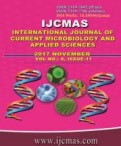


 National Academy of Agricultural Sciences (NAAS)
National Academy of Agricultural Sciences (NAAS)

|
PRINT ISSN : 2319-7692
Online ISSN : 2319-7706 Issues : 12 per year Publisher : Excellent Publishers Email : editorijcmas@gmail.com / submit@ijcmas.com Editor-in-chief: Dr.M.Prakash Index Copernicus ICV 2018: 95.39 NAAS RATING 2020: 5.38 |
To know about the transmission behavior, biological characterization of Sesamum phyllody disease was conducted. The leafhopper Orosius albicinctus (Dist.) could transmit the disease successfully in artificial inoculation. The rate of transmission of the disease increased significantly as the no. of leafhopper was increased from 1 per plant (29.47%) to 3 per plant (84.26%). The disease transmission also increased significantly as the acquisition feeding (AFP) period increased from 3 days (49.38%) to 5 days (64.75%). Likewise, lowest disease transmission (16.67%) was observed in plants with 5 days inoculation feeding period (IFP) and increased significantly in 10 IFP (100%). The interaction effect of no. of leaf hopper/plant, acquisition feeding period and inoculation feeding period also exhibited positive and significant increase in transmission. Highest disease incidence was observed in plants inoculating with 3 no of leafhopper per plant +5 days AFP + 7and 10 days IFP and lowest in treatment with 1 leafhopper per plant + 3 days AFP + 5days IFP. Similar effect was also observed in time period taken for first appearance of symptom. Lowest time period (25 days) for first appearance of symptom was taken when plants were inoculated with 3 no of leafhopper/plant + 5days AFP + 7 and 10 days IFP and highest (39days) in plants inoculated with 1 leafhopper/plant + 3 days AFP + 5days IFP. The Sesamum phyllody disease was successfully transmitted by graft transmission (80%) and dodder (90%) but it was not transmitted by seed and sap inoculation. There was no effect in germination of seeds collected from infected sesamum plants.
 |
 |
 |
 |
 |